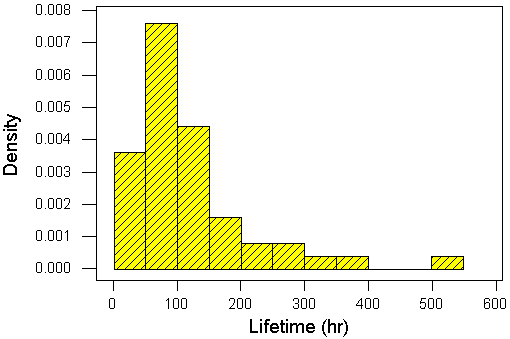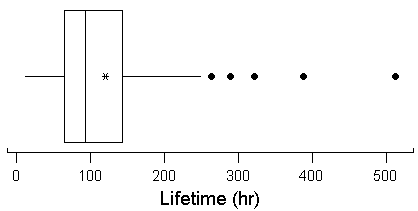Note that this question attempts to cover various aspects of descriptive statistics. In the actual test, there will be time to test only a portion of what is presented here. Only some of the information shown here will be presented in a question on the test.
The actual time, in hours, to failure of a prototype mechanical component in a turbine, is measured on fifty occasions in an experiment. The raw results are displayed here, sorted into increasing order:
| 11 | 14 | 20 | 23 | 31 | 36 | 39 | 44 | 47 | 50 |
| 59 | 61 | 65 | 67 | 68 | 71 | 74 | 76 | 78 | 79 |
| 81 | 84 | 85 | 89 | 91 | 93 | 96 | 99 | 101 | 104 |
| 105 | 105 | 112 | 118 | 123 | 136 | 139 | 141 | 148 | 158 |
| 161 | 168 | 184 | 206 | 248 | 263 | 289 | 322 | 388 | 513 |
The summary statistics include
![]()
- From the summary statistics, calculate the sample mean and sample standard deviation for these data.
- From the histogram below, identify the modal class.

- What evidence is there, from the histogram, for skewness?
- Use the histogram only, to estimate the number of components in the sample, whose lifetimes are less than 50 hours.
- A stem-and-leaf diagram for these data is
9 0 112233344 (19) 0 5566667777788889999 22 1 00001123344 11 1 5668 7 2 04 5 2 68 3 3 2 2 3 8 1 4 1 4 1 5 1Use this stem-and-leaf diagram to construct a frequency (and cumulative frequency) table and hence find the median class. - Find the median value from the original data.
- The asterisk in the boxplot below denotes the location of the
sample mean.
Describe the evidence for skewness that you can see in the boxplot.

- List all the outliers.
![Circuit A to R1 to
[parallel: (series {parallel R2, R4}, R5), R3] to B](t1images/t1pq7relay.gif)